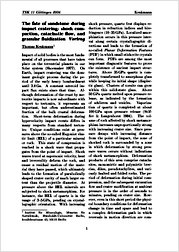The fate of sandstone during impact cratering: shock compaction, cataclastic flow, and granular fluidization
2006Universitätsverlag Göttingen
Article in Anthology
Verlagsversion
Deutsch
Kenkmann, Thomas, 2006: The fate of sandstone during impact cratering: shock compaction, cataclastic flow, and granular fluidization. In: Philipp, S.; Leiss, B; Vollbrecht, A.; Tanner, D.; Gudmundsson, A. (eds.): 11. Symposium "Tektonik, Struktur- und Kristallingeologie"; 2006, Univ.-Verl. Göttingen, S. 103 - 106., , DOI: 10.23689/fidgeo-1869.
 |
View/
|
Impact of solid bodies is the most fundamental
of all processes that have taken
place on the terrestrial planets in our
Solar system (Shoemaker 1977). On
Earth, impact cratering was the dominant
geologic process during the period
of the early heavy bombardment
until 3.8Ga. A constant asteroid impact
flux exists since that time. Although
deformation of the crust by meteorite
impacts is now subordinate with
respect to tectonics, it represents an
important, but often underestimated
fraction of the bulk crustal deformation.
Short-term deformation during
hypervelocity impact events differs in
many respects from standard tectonics:
Unique conditions exist at pressures
above the so-called Hugoniot elastic
limit (HEL) of a particular mineral
or rock. This state of compression is
reached in a shock wave that propagates
from the point of impact. Shock
waves travel at supersonic velocity, heat
and irreversibly deform the rock, and
cause a residual motion of the material
they have passed, which ultimately
leads to the formation of parabolically
shaped crater cavity of much larger extent
than the projectile diameter. At
pressure above the HEL minerals are
subjected to shock metamorphism...

